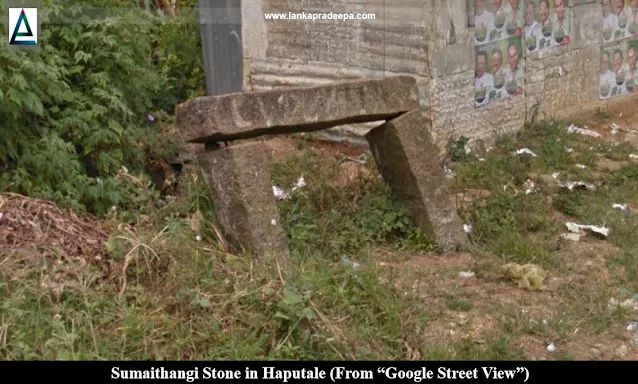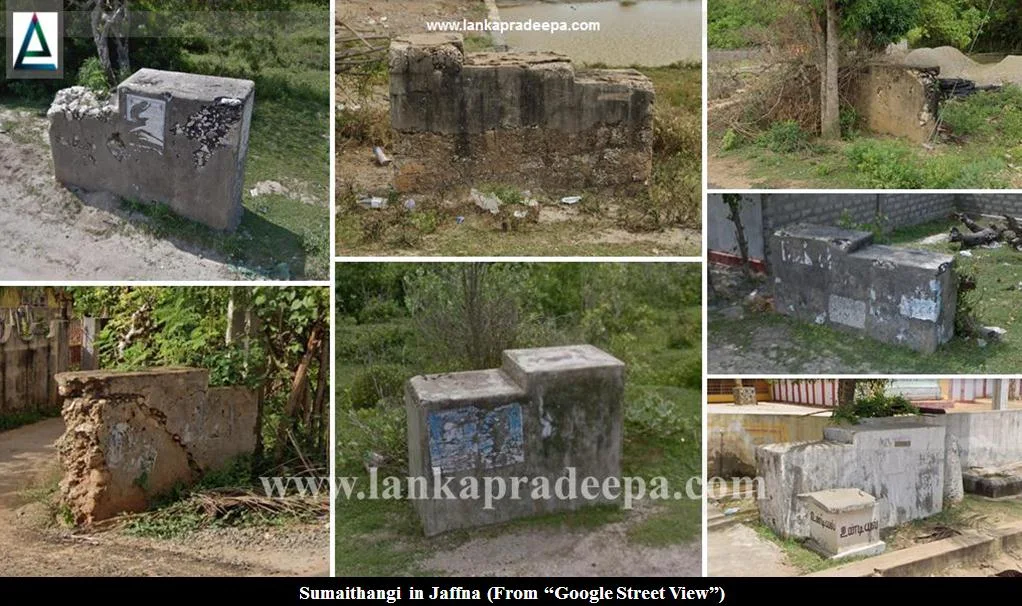
Of the various archaeological artefacts discovered all over Sri Lanka, Aavuranchikkal and Sumaithangi are only found in several regions of the country, especially in Jaffna District (Dias et al., 2016; Wijebandara, 2014). It is believed that these two artefacts were a unique part of the Tamil Hindu culture that prevailed in the old Jaffna society before the arrival of the Portuguese in the 16th century A.D. (Wijebandara, 2014).
Aavuranchikkal and Sumaithangi along with Madam (traditional resting places built to accommodate wayfarers who were travelling to distant places) and Keni are found along the roads in towns, around industrial centres, in barren lands and other places in Jaffna
such as Kandarodai, Kalviyankadu, Anaikkoddai, Vadamarachchi,
Udupiddy, Valikamam, Point Pedro, Nallur, Chunnakam, Karainagar, and
Chankanai (Dias et al., 2016; Pushparatnam, 2014; Wijebandara, 2014). Of them, those found in Vadamarachchi and Udupiddy
contain inscriptions as well (Dias et al., 2016).
Besides these artefacts in Jaffna, a different type of Sumaithangi stones has been recorded in places such as Hatton, Haputale etc.
Origin
Before the creation of motor vehicles, people had to travel long distances on foot or by bullock carts for the transport of men and goods (Pushparatnam, 2014). Therefore, the people in the north constructed Aavuranchikkal, Sumaithangi, Madam and Keni for the benefit and necessities of the people and livestock along paths, roads, streets and around the places where travelling people gather for various purposes including resting (Pushparatnam, 2014). As what happened to the Hindu shrines in the northern region, these structures were not destroyed by the Portuguese (1597-1658 A.D.) and the Dutch (1658-1796) as they were small in size (Pushparatnam, 2014).
Aavuranchikkal
Aavuranchikal (or Aavurancikal, Aavuragnchikkal, Aavuronchi kallu, Mandekkal, Aadenkuttiare) is a single piece of a short stone pillar (mostly limestone) with a circular, elliptical or square cross-section buried to a depth of about 1.5 ft. and protruding about 2 ft. from the ground (Dias et al., 2016; Wijebandara, 2014). In the Tamil language "Aa" refers to the bullock and "Ranchi" means to rub (Dias et al., 2016; Wijebandara, 2014). Therefore, this artefact is assumed to be an object that deals with some activity involving cattle (Dias et al., 2016). Some believe these stones have been erected for the cattle to relieve themselves from an itch called Thinavu by rubbing against the stone (Ragupathy, 1987). Aavuranchikals are usually found near sources of drinking water where cattle and livestock can quench their thirst (Pushparatnam, 2014).
However, in old Tamil literature, Aavuranchikal was known by several names such as Mantaikkal, Atintukkutti, Titukkutti, Aroncikkal, Avunci etc. (Pushparatnam, 2014). The text Tirumurukarruppatai mentions that the Hindu God Murugan dwells in the Avurancikal (Pushparatnam, 2014). As the construction of Aavuranchikkals was considered a status symbol, they were said to have been constructed by rich people in the old society (Pushparatnam, 2014).
Some Aavuranchikkals have been inscribed with images of deities and other religious symbols (Pushparatnam, 2014). Some have been erected as tombstones or as a Lingam, the symbol of God Siva (Pushparatnam, 2014; Wijebandara, 2014).
Sumaithangi
Sumaithangi (or Cumaitanki) is about 2 ft. thick, 5 to 6 ft. wide and 3 to 5 ft. tall stone-built wall similar to a platform. Before the introduction of modern methods of quick transport, these short platforms were used by ancient travellers to relieve themselves for a while by unloading the goods carried on their heads, shoulders or waists (Pushparatnam, 2014; Ragupathy, 1987; Wijebandara, 2014). Therefore the height of Sumaithangi at its maximum point is made to level with an average person's height to ensure an easy transfer of loads between the platform and the bearer's head without others' help. Like Aavuranchikkal, the Sumaithangi was also in use among the people for a long time in the past (Pushparatnam, 2014).

It is recorded from the Vadamarachchi area that a structure similar to Sumaithangi had been erected by locals as a symbol of prayer,
vowing for the soul of a mother who dies pregnant to rest in peace (Wijebandara, 2014). According to the Tamil Lexicon, when a pregnant woman dies before childbirth, a Sumaithangi is constructed with the notion of relieving her pain (Pushparatnam, 2014). In some Sumaithangikals, a short detail of the deceased is found inscribed with the religious symbols of deities (Pushparatnam, 2014).
Sumaithangi outside Jaffna
There are simple structures erected by balancing a horizontal stone slab on two vertical stone posts in some places outside Jaffna such as Hatton and Haputale and they are also called by locals as Sumaithangi. The one in Hatton is marked with the date 16.11.1938.
Keni
In the Tamil language, Keni is called by many names, viz; Cirukulam, Kinaru and Turucu (Pushparatnam, 2014). From the mouth of the Keni, the land descends gradually to reach the water which is at the lower level to facilitate the cattle and livestock to climb down the Keni and drink water (Pushparatnam, 2014). Sometimes, small wells were dug for the use of the people separately (Pushparatnam, 2014).
 .
.
References
1) Dias, M.;
Koralage, S.B.; Asanga, K., 2016. The archaeological heritage of Jaffna
peninsula. Department of Archaeology. Colombo. p.225.
2) Pushparatnam, P., 2014. Tourism and monuments of archaeological heritage in Northern Sri Lanka. Author Publication. ISBN: 978-955-0811-08-3. pp.76-83.
3) Ragupathy, P. 1987. Early settlements in Jaffna, An archaeological
survey. Published by Mrs. Thilimalar Ragupathy. Madras. p.156.
4) Wijebandara, I.D.M., 2014. Yapanaye Aithihasika Urumaya (In Sinhala).
Published by the editor. ISBN-978-955-9159-95-7. pp.143-147.
This page was last updated on 28 October 2023

